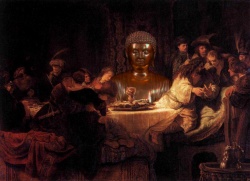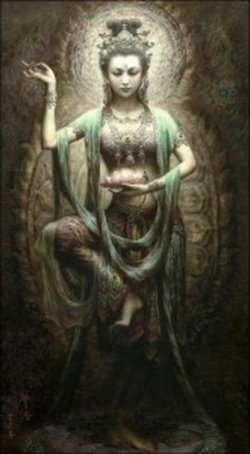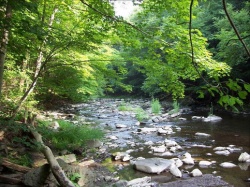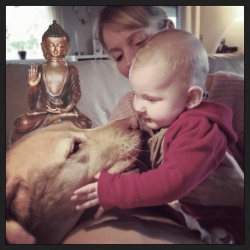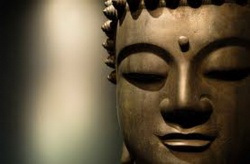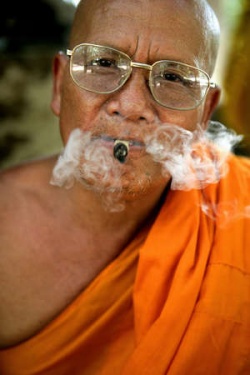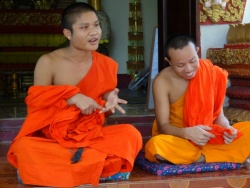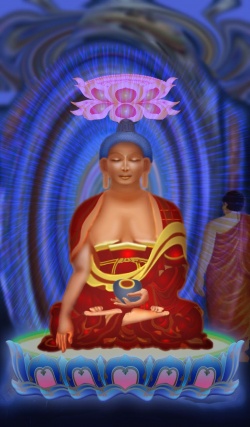Serkong Rinpoche's Life and Personality
Rinpoche’s Role as an Assistant Tutor of the Dalai Lama
Tsenzhab Serkong Rinpoche was a massive man – a monk with shaved head, red robes, and a deeply lined face that made him look more ancient than his years. His humble, wise manner and gentle humor made him appear like the archetypal sage of fables. This quality did not escape the notice of Westerners who met him. Upon seeing him in Dharamsala, for instance, the makers of the popular film Star Wars decided to use him as the model for Yoda, the spiritual guide of the epic. Rinpoche never saw the movie, but would undoubtedly have been amused at the caricature. Rinpoche’s most outstanding feature, however, was his relationship with His Holiness the Dalai Lama.
The Dalai Lama is the spiritual and temporal leader of Tibet. His line of succession continues through reincarnation. Upon the death of a Dalai Lama, his closest associates follow a complex procedure to identify and locate his rebirth as a small child. Subsequently, each new Dalai Lama receives the best education available from the most qualified teachers. These mentors include a senior and a junior tutor, and seven tsenzhab, commonly translated as "assistant tutors."
Tibetan Buddhism has four major traditions, transmitted from India through different lineages, but without major contradictions in their fundamental teachings. The Dalai Lama’s nine core teachers come from the Gelug tradition, the largest of the four. He studies with masters of the other three lineages – Nyingma, Kagyu, and Sakya – once his basic education is complete. The seven tsenzhab come, one each, from the seven major Gelug monasteries near Lhasa, the capital of Tibet. T
hey are chosen based on their learning, their meditation accomplishment, and, above all, their character development. Serkong Rinpoche was the tsenzhab appointed from Ganden Jangtsey, the monastery established by Tsongkhapa himself, the founder of the Gelug tradition. He was 34 when he assumed this position in 1948; the Dalai Lama was 13. He was the only one of the seven tsenzhab who was able to join His Holiness in exile in India in 1959.
Areas of Rinpoche’s Expertise
Until his passing away in August 1983, Rinpoche faithfully served His Holiness, first in Lhasa and later in Dharamsala. His main duty was to attend all the lessons His Holiness received and then to debate with him afterwards to insure His Holiness’s correct understanding. In fact, His Holiness insisted that Rinpoche join him at every teaching he received, so that at least one other lama would share the full breadth of his education and training. Thus, like His Holiness, Rinpoche was a master of all four Tibetan traditions. His expertise spanned the full range of the two major divisions of the Buddhist training, sutra and tantra. The sutras transmit the basic teachings, while the tantras contain the deepest-reaching methods for self-transformation.
Rinpoche was also well accomplished in the traditional Buddhist arts and sciences. For example, he was expert in the measurements and construction of the two and three-dimensional symbolic world-systems (mandala) used in tantric ritual and of the various types of monuments (stupa) used to house relics. Further, he was a master of poetry, composition, and Tibetan grammar. His teaching style thus had an elegance and sensitivity that balanced beautifully his concern for technical detail.
Serkong Rinpoche was also an expert in the Tibetan form of divination (mo). In this system, one enters a concentrated state of meditation, throws three dice several times, and interprets the results to help people make difficult decisions. Moreover, he also knew Tibetan astrology, which involves mastering complex mathematics for calculating the position of the planets. His approach to these esoteric subjects, however, was always pragmatic and down to earth. Consulting them is to supplement, not to replace the use of commonsense judgment.
Rinpoche’s Humility at Being a Teacher of the Dalai Lama
Despite the importance of his official position and the breadth of his learning, Rinpoche always remained humble. Although he was in fact one of the major teachers of His Holiness – particularly of Kalachakra (cycles of time), the most complex of the tantra systems – and although he conferred upon his star pupil many tantric empowerments, he never liked being called "Assistant Tutor" in English. He wished his title tsenzhab to be translated literally as "Debate Servant," but finally agreed on the translation "Master Debate Partner."
Serkong Rinpoche served His Holiness in both formal and informal ways. For example, His Holiness frequently performs special meditation practices and ritual ceremonies (puja) for the welfare of the world in general and of his people in particular. Some of these he does in private, some with a handful of select monks, and others before a large assembly. His Holiness customarily requested Rinpoche to join him in these procedures or to perform or preside over them on his behalf if he were too busy with other matters. Moreover, when His Holiness would teach, Rinpoche would sit at his right side, supplying any words if His Holiness needed, or answering any questions or doubts if His Holiness asked. When others were too shy to transmit teachings or lineages directly to His Holiness, they would pass them to Rinpoche. Like a spiritual funnel, Rinpoche would then offer them to His Holiness.
Diplomatic Skills
His Holiness often referred to Serkong Rinpoche as his advisor and chief lieutenant for bringing his policies to the monasteries and to the public. This was because Rinpoche was a master diplomat in both the religious and secular spheres. He often mediated in local disputes and advised His Holiness’s offices on local protocol in the areas he knew.
A warm sense of humor greatly enhanced his diplomatic skills. People often came to tell him jokes and funny stories, not only because he laughed and appreciated them so much, but also because he would then tell them so well to others. His entire body would shake with laughter, which was totally infectious to everyone around him. This combination of practical wisdom and hearty humor greatly endeared him to whomever he met.
Re-establishing Monasteries and Training the Mediums for the State Oracles
Rinpoche was instrumental in re-establishing in India many of the monasteries and nunneries that the Chinese invasion had destroyed in Tibet. He did this by giving empowerments and teachings so that they could resume their traditional rituals. This was particularly true with the monasteries of the two state oracles, Nechung and Gadong, with which he maintained a close relation throughout his life. Just as Rinpoche served as His Holiness’s principal human advisor, the state oracles are the Dalai Lama’s traditional supernatural consultants. They speak to him through a medium in trance. Rinpoche supervised the spiritual training of the mediums so that they could become pure channels for higher wisdom.
Rinpoche never shunned hardship for the sake of receiving or imparting Buddha’s teachings. For example, one summer he endured the intense heat of Bodh Gaya in order to receive instruction there from Kunu Lama Rinpoche on Kalachakra. This great teacher from Kinnaur, a Tibetan cultural area on the Indian side of the Himalayas, was the only living master in modern times whom all Tibetans recognized as a bodhisattva. A bodhisattva is someone totally selfless and fully dedicated to achieving enlightenment to benefit others. Bodh Gaya is the holy site where Buddha became enlightened under the bodhi tree. It lies in the poorest and hottest region of India. In summer, the temperature regularly soars to120 degrees Fahrenheit, which is nearly 50 degrees Centigrade. With frequent power cuts, water shortages, and no air conditioning, being there can be quite a trial. Kunu Lama regularly lived there in a tiny windowless room without even a fan.
Reforming Buddhism in the Himalayan Valley of Spiti
Rinpoche traveled extensively to teach in India, Nepal, and twice in Western Europe and North America. Although he visited major centers, he always preferred small, remote places where teachers were rare and others did not wish to go. For instance, sometimes he would travel by yak to teach the soldiers in the Tibetan division of the Indian army on the Indo-Tibetan border. He would camp out in tents at high altitudes, never minding the discomfort.
From among these remote border regions, Rinpoche had an especially close connection with Spiti, the high Indian Himalayan valley next to Kinnaur, where he both passed away and was reborn. A thousand years ago, this barren, dust-covered district was included in Tibet and was the center of a renaissance of Buddhism. In recent times, however, the standards had fallen, as they had done a millennium earlier. The monks ignored their vows of celibacy and of abstinence from alcohol. They studied and practiced little of Buddha’s actual teachings.
Through his five visits to the valley, Rinpoche sought to create a second renaissance. He did this by rededicating the most ancient monastery in Spiti, Tabo Gonpa, and conferring on its monks the empowerments and oral transmissions for its traditional rituals. He imported learned spiritual teachers and founded a school for the local children. Finally, in July 1983, Rinpoche organized inviting His Holiness the Dalai Lama to confer the Kalachakra initiation at Tabo. The introduction of the Kalachakra teachings from India to Tibet in 1027 had become the landmark event confirming the reestablishment of Buddhism there after a long period of confusion. He hoped that the current empowerment would serve the same purpose.
Making Extensive Offerings to Monasteries
Serkong Rinpoche was also a great patron of the teachings. Whatever offerings he received in Spiti, for example, he donated back to the monastery. With this generous endowment, Tabo Gonpa was able to start an annual prayer festival during which the local people gather for three days of chanting om mani padme hum. These sacred syllables (mantra) are associated with Avalokiteshvara, the Buddha-figure (yidam) embodying compassion and especially close to all followers of Tibetan Buddhism. Chanting this mantra helps to keep focused on love for all beings.
Rinpoche used the offerings he received from his first Western tour to commission a huge applique scroll portraying the Buddha-figure Kalachakra. He presented it to His Holiness for use when traveling to different areas to confer the empowerment into this meditation system. He also commissioned with this money a full set of scroll-paintings of the life of Tsongkhapa, which he presented to his monastery, Ganden Jangtsey. Years earlier, he had helped to reestablish it in Mundgod, South India. With the donations he received during his second Western tour, he made extensive offerings to the more than 4000 monks and nuns who gathered at Drepung Monastery, Mundgod, in March 1983 for the first full Monlam celebration in India. The Monlam is the prayer festival traditionally held in Lhasa at which all monastics gather for a month of communal devotions.
Dislike of Formality and Practice of Simplicity
Although Rinpoche was a master of ritual and protocol, he remained unpretentious and disliked formalities. When he traveled to the West, for example, he never brought with him ornate ritual implements or paintings. Whenever he conferred an empowerment there, he personally drew any figures he needed, substituted cookies or cake for the sculpted dough offerings (torma), and used flower vases or even milk bottles for the ritual vases. When no special preparations were made during his travels for the bimonthly tsog ritual – a ceremony during which consecrated alcohol, meat, tormas, fruit, and candies are offered – he would silently offer whatever meal he was served.
Moreover, Rinpoche always presented Buddha’s teachings in accordance with his audience. Once Rinpoche was invited to the Mount Tremper Zen Center near Woodstock, New York. The members requested him to confer a permission ceremony (jenang) for the practice of Manjushri, the Buddha-figure embodying wisdom. In keeping with the Zen tradition of simplicity, Rinpoche sat on the floor, not on a throne, and imparted the jenang without any ritual instruments or an ornate ceremony.
Being Unpretentious and Sincerely Humble
His Holiness often described Tsenzhab Serkong Rinpoche as a real Kadampa Geshe. The Kadampa Geshes were Tibetan Buddhist masters of the eleventh through thirteenth centuries who were noted for their sincere, direct practice and humility. At one discourse, for instance, His Holiness, referring to Rinpoche, said that the only one sitting humbly here is someone who has no need to at all, while everyone else is sitting arrogantly. Once, when asked for his main advice, Rinpoche said to be always humble, unpretentious, have a warm heart, and take everyone seriously.
Rinpoche lived his life totally according to this advice. Once Rinpoche stayed in a large apartment of a good family in Milan, Italy. Most high lamas who came to this city had stayed in this home. The grandmother of the house said that of all these lamas, she liked Serkong Rinpoche the most. The others would sit in their rooms very formally and take their meals by themselves. By contrast, Serkong Rinpoche would come into the kitchen in his underskirt and undershirt early in the morning. He would drink his tea unpretentiously at the kitchen table, saying mantras with his prayer beads, totally relaxed and smiling, while she prepared breakfast.
Skill in Teaching Others Humility and Taking Everyone Seriously
Rinpoche also taught others to drop all pretenses. Once the Western monks of Nalanda Monastery in Lavaur, France, invited Rinpoche to teach for three days. They requested an explanation of the extremely difficult chapter on wisdom from Engaging in Bodhisattva Behavior (Bodhicharyavatara) by the eighth-century Indian master Shantideva. Rinpoche began the discourse by explaining voidness on such a sophisticated and complicated level, no one could keep up. Then Rinpoche stopped and scolded the monks for having been so pretentious. He told them that if Tsongkhapa had such difficulty in gaining a correct comprehension of voidness and spent so much effort in preliminary practices, how could they possibly think it was easy and that they would understand the entire subject in three days. Rinpoche then continued teaching the text on a simpler level, which the monks could now follow.
Rinpoche once said that nothing impressed him about the West except the sincere interest that so many people have for Buddha’s teachings. Thus, no matter who requested instruction, he respected their interest. Although he taught them at the level they could understand, he always drew them slightly beyond what they imagined to be their capacity. Rinpoche, who loved circuses, used to say that if a bear can be taught to ride a bicycle, then with skillful means and patience, a human being can be taught anything.
Once a hippy-looking Westerner, new to Buddhism and dazed on drugs, asked Rinpoche to teach him the six practices of Naropa. Normally, one studies this extremely advanced topic only after many years of intensive meditation. Instead of dismissing the young man as preposterous and arrogant, Rinpoche agreed, telling him that his interest was excellent. First, however, he would need to prepare himself, and so Rinpoche taught him the preliminary practices. By taking seriously people’s interest in self-development, Rinpoche inspired many Westerners to take themselves seriously. This greatly helped them to proceed on the spiritual path.
No matter whom he met, whether His Holiness the Pope, a drunk in the street, or a group of children, Rinpoche treated them all with equanimity and equal respect. He never looked down on, sought the favor of, or tried to impress anyone. Once, the members of Wisdom’s Golden Rod Center in Ithaca, New York, requested Rinpoche to speak to their children. He told the youngsters how much he respected them because they were young and open-minded. They had the potential to surpass their parents. In this way, he inspired the children to respect themselves. Ability to Recognize Special Karmic Connections
Although Serkong Rinpoche could frequently see the karmic relation he had with people he met, he never pretended to be able to help more than he could. Once a Swiss man approached him in Dharamsala and explained that he was plagued with trouble from ghosts. Rinpoche responded that he did not have the karmic relation to help him with this problem, and then directed the man to another lama who did. Others, however, Rinpoche seemed to recognize instantly and, upon first meeting, would ask his attendants to take down these persons’ addresses. Inevitably, deep relationships developed. I was among these fortunate people, although Rinpoche saw no need to take my address. I would return.
